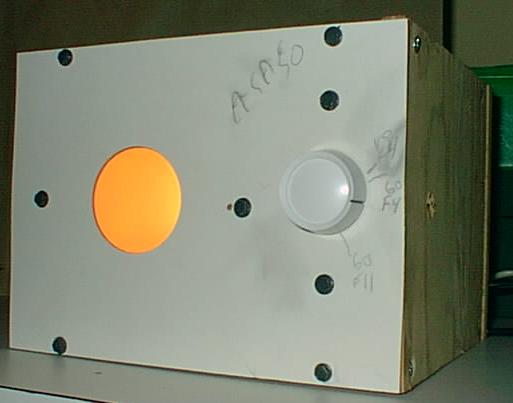A Variable Light Source For Camera Meter Testing
Disclaimer
I will not be held responsible for any damage that results from you looking
at or following these notes. If you don't feel comfortable goofing around
with this stuff or the possibility that you could damage something on your
camera, just don't do it.
Build your own variable light source
I spent quite of bit of time trying to calibrate my light meters using
available light sources such as:
- northern clear blue sky
- green grass
- table lamp - through lampshade
The major problem with these light sources is that they are not variable
in a controlled fashion nor readily repeatable.
 Finally I came to my senses and built my own variable light source. It
cost me less than 25 dollars for the materials I did not happen to have stashed
away in various junk boxes. Here is a list of major components, along with
some notes. Please beware of the danger of fire from any enclosed heat source
such as a light bulb and take appropriate precautions.
Finally I came to my senses and built my own variable light source. It
cost me less than 25 dollars for the materials I did not happen to have stashed
away in various junk boxes. Here is a list of major components, along with
some notes. Please beware of the danger of fire from any enclosed heat source
such as a light bulb and take appropriate precautions.
- plywood - enough to build the box. I think I used 15/32" thick stock
from my scrap pile. The box, as built, contains a ventilated divider that
separates the lamp from the electronic components. The light portion of my
box is big enough to hold a number of different kinds of light bulbs, ranging
from ordinary frosted bulbs to outdoor flood lamps. Right now I'm using
an ordinary 60 watt frosted bulb, which seems to work pretty well.
- white formica counter top material- enough to cover the inside of the
light box - optional, but will help reflect and diffuse light better.
- white formica counter top material- a piece big enough to cover the
front of the box. As you can see in my picture, I'm able to write on the
formica with a pencil to mark certain interesting levels next to the dimmer
switch. I used a hole saw to drill a circle 2" in diameter in the center
of the light box section. The typical 50mm lens for a typical 35mm camera
fits nicely against this size opening.
- lamp socket - the kind used for ceiling fixtures in basements worked
well for me.
- electric cord and plug.
- dimmer switch - I cut a line in the knob to use in conjunction with
the lines penciled on the white formica background.
- frosted glass - used to diffuse the light and prevent "hot spots" -
a small square piece can be purchased at most any glass shop. Mine is 4.5
by 4.5 inches and is mounted in a wooden frame mounted to the rear of the
formica face plate.
- small 12VDC fan - used to prevent the lamp or electronics from heating
the box up enough to cause problems, such as a house fire. I found a very
small one at Radio Shack that could be powered by a small 12VDC "wall wart"
power supply. I wouldn't build or operate an enclosed box like this without
a positive cooling system.
- 9VDC "wall wart" power supply - to power the fan - I saved this in
days past from a broken telephone answering machine - it really supplies over
10VDC under this load and the 12VDC fan is specified down to 10VDC, so this
worked out okay in my application. Your mileage my vary. My fan is wired
so that it is always on when the variable light source is plugged in, no
matter what the state of the lamp is.
Back to Mike's Hobby
Home Page

